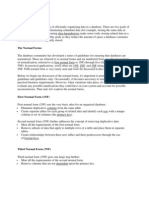1.what Is Data Normalization
Uploaded by
Nguyễn Quốc Huy1.what Is Data Normalization
Uploaded by
Nguyễn Quốc Huy1.What is Data Normalization: Store only the minimal amount of information Remove redundancies. Restructure data.
2.Benefit of Data Normalization: Decrease storage requirements. Faster search performance. Improved data integrity.
3.Kinds of Normal Forms(NF): 1NF 2NF 3NF BCNF (Boyce-codd) 4NF 5NF
(Normal forms above 3NF are mainly for academics, and are not seen very often in the nature.) 4. 1NF 5. 2NF 6. 3NF Table must be 2NF. All columns must be relative directly to the primary key. Table must be in 1NF. Remove vertical redundancy. (the same value shouldnt repeat across row) Composite key. (all columns in a row must refer to BOTH path of key). Remove horizontal redundancies. (No 2 columns hold the same information, No single column holds more than a single item) Each row must be unique. (Use a primary key)
7. Example
You might also like
- Database-Normalization-Ensuring-Data-Integrity-and-EfficiencyNo ratings yetDatabase-Normalization-Ensuring-Data-Integrity-and-Efficiency10 pages
- Normalization-in-Database-Management-Systems.pptx[1]No ratings yetNormalization-in-Database-Management-Systems.pptx[1]10 pages
- Relational Data Modeling: Presented By: Samarth B. PandyaNo ratings yetRelational Data Modeling: Presented By: Samarth B. Pandya18 pages
- Example:: Searching Stored Procedures Across SQL Server DatabasesNo ratings yetExample:: Searching Stored Procedures Across SQL Server Databases4 pages
- Crime Data Mining: An Overview and Case StudiesNo ratings yetCrime Data Mining: An Overview and Case Studies5 pages

































































